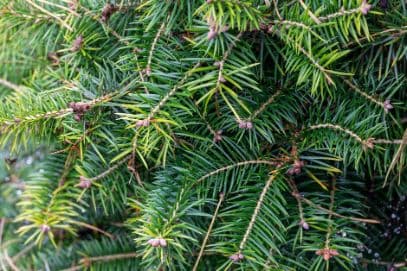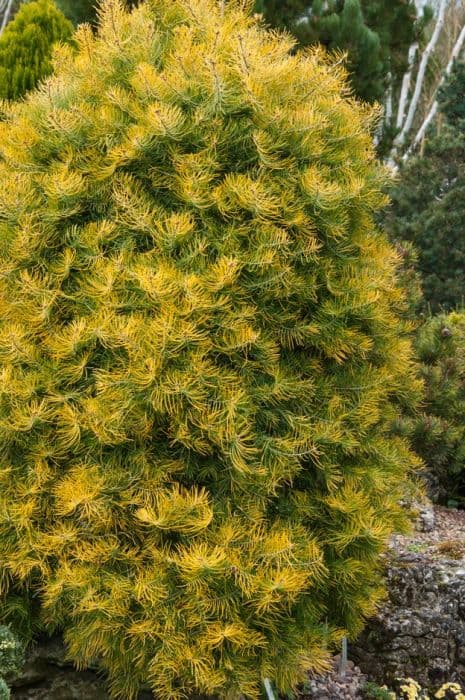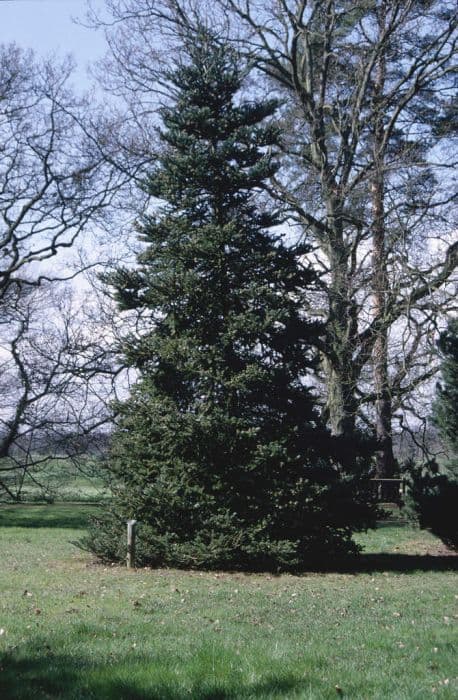Mugo Pine Pinus mugo 'Kissen'

ABOUT
The Pinus mugo 'Kissen', commonly known as the Mugo Pine 'Kissen', is a dwarf conifer variety recognized for its distinctive lush and rich green needles. These needles typically form in pairs and are slightly curved, providing a full and robust appearance to the plant. The texture they create is dense, contributing to the plant's compact and cushion-like shape, hence the name 'Kissen', which means 'cushion' in German. Over time, the Mugo Pine 'Kissen' develops into a low, mounded form. Its needles remain vibrant throughout the year, making it an excellent choice for adding evergreen interest to a garden setting. On close inspection, the surface of the needles has a fine, linear texture, adding to their aesthetic appeal. One of the charming features of this dwarf pine is the production of small, brownish to tan cones, which can be seen nestled among the needles. These cones start off quite small and inconspicuous, but as they mature, they become more noticeable against the green backdrop of the foliage. The bark of the Mugo Pine 'Kissen' has a rugged texture that contrasts nicely with the softness of the needles. Overall, the Mugo Pine 'Kissen' is appreciated for its neat, rounded shape, and its striking green needles that remain attractive all year round. The plant's structure and texture make it a popular choice for rock gardens, as a groundcover, or in mixed borders, where its evergreen presence can be enjoyed regardless of the season.
About this plant
 Names
NamesFamily
Pinaceae.
Synonyms
Mugho Pine, Mountain Pine, Swiss Mountain Pine, Dwarf Mountain Pine, Mugo Pine, Kissin Pine.
Common names
Pinus mugo 'Kissen'
 Toxicity
ToxicityTo humans
The Mugo Pine, specifically the cultivar 'Kissen', is generally not considered toxic to humans. There are no well-documented cases of poisoning from ingesting parts of this plant. However, ingesting pine needles or other parts of pine trees can potentially cause gastrointestinal irritation or discomfort due to the fibrous and resinous nature of the plant material. It's always advisable to exercise caution and avoid eating parts of ornamental plants due to potential individual allergies or unknown reactions.
To pets
The Mugo Pine, specifically the cultivar 'Kissen', is not commonly known to be toxic to pets either. While it is generally safe, if pets consume a large quantity of pine needles, they could experience gastrointestinal upset or irritation, as pine needles can be difficult to digest. It is always best to prevent pets from eating non-food plants, as individual sensitivity can vary and there is a risk of mechanical injury from sharp or pointed plant parts.
 Characteristics
CharacteristicsLife cycle
Perennials
Foliage type
Evergreen
Color of leaves
Green
Height
1-2 feet (30-60 cm)
Spread
1-2 feet (30-60 cm)
Plant type
Shrub
Hardiness zones
2-8
Native area
Europe
Benefits
 General Benefits
General Benefits- Low Maintenance: This plant requires minimal care once established, making it ideal for gardeners seeking low-maintenance landscaping options.
- Year-Round Interest: With its evergreen foliage, Pinus mugo 'Kissen' provides color and texture in the garden throughout all seasons.
- Erosion Control: The dense roots can help stabilize slopes and prevent soil erosion.
- Habitat for Wildlife: It offers shelter and nesting sites for birds and other wildlife within a garden setting.
- Drought Tolerance: Once established, this plant can withstand periods of low water availability.
- Cold Hardy: It is well-suited to cold climates and can tolerate frost and snow without significant damage.
- Adaptable to Soil Types: This plant can thrive in a variety of soil conditions, from sandy to clay soils.
- Windbreak: Dense foliage makes it effective as a windbreak or natural barrier.
- Compact Size: Its small stature allows it to be planted in smaller gardens or landscape areas without worrying about it outgrowing the space.
- Ornamental Appeal: Provides aesthetic value with its distinct shape and lush green needles.
 Medical Properties
Medical PropertiesThis plant is not used for medical purposes.
 Air-purifying Qualities
Air-purifying QualitiesThis plant is not specifically known for air purifying qualities.
 Other Uses
Other Uses- Miniature pine forests in model train setups: Pinus mugo 'Kissen' is compact and can mimic full-size pine trees in miniature landscapes for model trains.
- Bonsai: Due to its small size and slow growth habit, the mountain pine is a popular choice for creating bonsai trees.
- Erosion control: The extensive root system of the mountain pine makes it ideal for planting on slopes to prevent soil erosion.
- Roof gardens: The dwarf nature of the mountain pine allows it to be used in roof gardens where space and weight are limited.
- Natural insect repellent: The scent of its needles and sap can deter certain insects, making it a candidate for natural pest control in gardens.
- Photography prop: Photographers sometimes use the mountain pine for its aesthetic appeal in creating natural-looking backdrops.
- Privacy screens in small spaces: Its dense foliage allows it to be planted as a screen for privacy in small gardens or patios.
- Theme gardens: Mountain pine can be used in Alpine or rock gardens to maintain the mountainous theme.
- Wildlife habitat: Its dense branches provide shelter and nesting sites for birds and other small animals in urban and suburban gardens.
- Education: It can serve an educational purpose, teaching about plant care and alpine species in school gardens or botanical gardens.
Interesting Facts
 Feng Shui
Feng ShuiMugo Pine is not used in Feng Shui practice.
 Zodiac Sign Compitability
Zodiac Sign CompitabilityMugo Pine is not used in astrology practice.
 Plant Symbolism
Plant Symbolism- Resilience: The mugo pine, often found in harsh mountainous environments, represents the ability to withstand challenging conditions and recover from adversity.
- Longevity: As a species that can live for many years, the mugo pine symbolizes a long life and endurance through time.
- Steadfastness: With its sturdy growth habit, this plant embodies reliability and the steadfastness of character.
- Protection: The evergreen nature of the mugo pine, which keeps its leaves throughout seasons, has historically been seen as a symbol of protection and immortality.
 Water
WaterThe Mugo Pine (often referred to as the Swiss Mountain Pine) prefers moderate watering, with a frequency of once a week during dry periods. It is vital to allow the soil to dry slightly between waterings to prevent root rot. Depending on the size and age of the plant, as well as environmental conditions, a young Mugo Pine may need about 1-2 gallons of water, while mature trees will generally require more due to their larger root systems. During the winter when the tree is dormant, watering can be cut back to once every two weeks or less, depending on rainfall and soil moisture levels.
 Light
LightMugo Pine thrives best in full sun, so it's important to position it in a spot where it will receive at least six hours of direct sunlight each day. Although it can tolerate partial shade, too much shade may result in sparse, weakened growth, so ensure that it's planted in an area free from taller structures or trees that might block the light.
 Temperature
TemperatureThe Mugo Pine is hardy and adaptable to a range of temperatures, capable of withstanding temperatures as low as -50 degrees Fahrenheit and as high as 90 degrees Fahrenheit. However, it thrives in cooler climates and prefers temperatures between 60 and 70 degrees Fahrenheit during the growing season.
 Pruning
PruningPruning the Mugo Pine is done primarily for shaping and to maintain its size. Prune in late winter or early spring, before new growth starts. It's typically pruned once a year, cutting back the candle-like new growth by about half. This pruning technique helps keep the pine compact and encourages denser foliage.
 Cleaning
CleaningNot needed
 Soil
SoilThe Dwarf Mugo Pine 'Kissen' prefers well-draining, sandy or loamy soil with a pH range of 5.5 to 7.0. A mixture of one-third topsoil, one-third peat moss, and one-third sharp sand or perlite is ideal for potting or planting in the ground.
 Repotting
RepottingDwarf Mugo Pine 'Kissen' is a slow-growing plant that typically requires repotting every 2 to 4 years. Due to its slow growth, it's generally best to repot when the root system has filled the current container.
 Humidity & Misting
Humidity & MistingDwarf Mugo Pine 'Kissen' is tolerant of a wide range of humidity levels. It thrives in outdoor conditions where it can receive natural ambient humidity without the need for additional humidity controls.
 Suitable locations
Suitable locationsIndoor
Ensure bright light, cool temps, and good air circulation.
Outdoor
Plant in full sun, well-drained soil; mulch roots for protection.
Hardiness zone
2-8 USDA
 Life cycle
Life cycleThe Dwarf Mountain Pine (Pinus mugo 'Kissen') begins its life as a seed, typically produced in cones that are pollinated by wind. Upon germination, the seedling emerges, developing a taproot and initial needles. As it enters the juvenile phase, it forms a compact, bushy growth habit, staying relatively low to the ground. The plant reaches maturity in several years, during which it develops a woody stem and a more extensive root system, while also producing its own cones. The mature Dwarf Mountain Pine can live for many decades, during which time it will continually produce cones annually or biennially, depending on environmental conditions. Throughout its life, the plant will go through cyclical growth each year, with new needles emerging in the spring and old needles being shed after several years.
 Propogation
PropogationPropogation time
Late winter
The most popular method of propagation for the Pinus mugo 'Kissen', commonly known as the Dwarf Mugo Pine, is through seed. Seeds are usually sown in the fall after they are harvested. The seeds need a period of cold stratification to break their dormancy, which would naturally occur through the winter months. To simulate this process artificially, the seeds can be mixed with slightly moist sand and stored in the refrigerator for about 1-3 months at a temperature of 34-41 degrees Fahrenheit (1-5 degrees Celsius). After stratification, seeds are sown in well-drained soil and placed in a sunny location. It generally takes a few weeks for germination to occur, and once seedlings are sufficiently strong, they can be transplanted to their final location in the garden.









